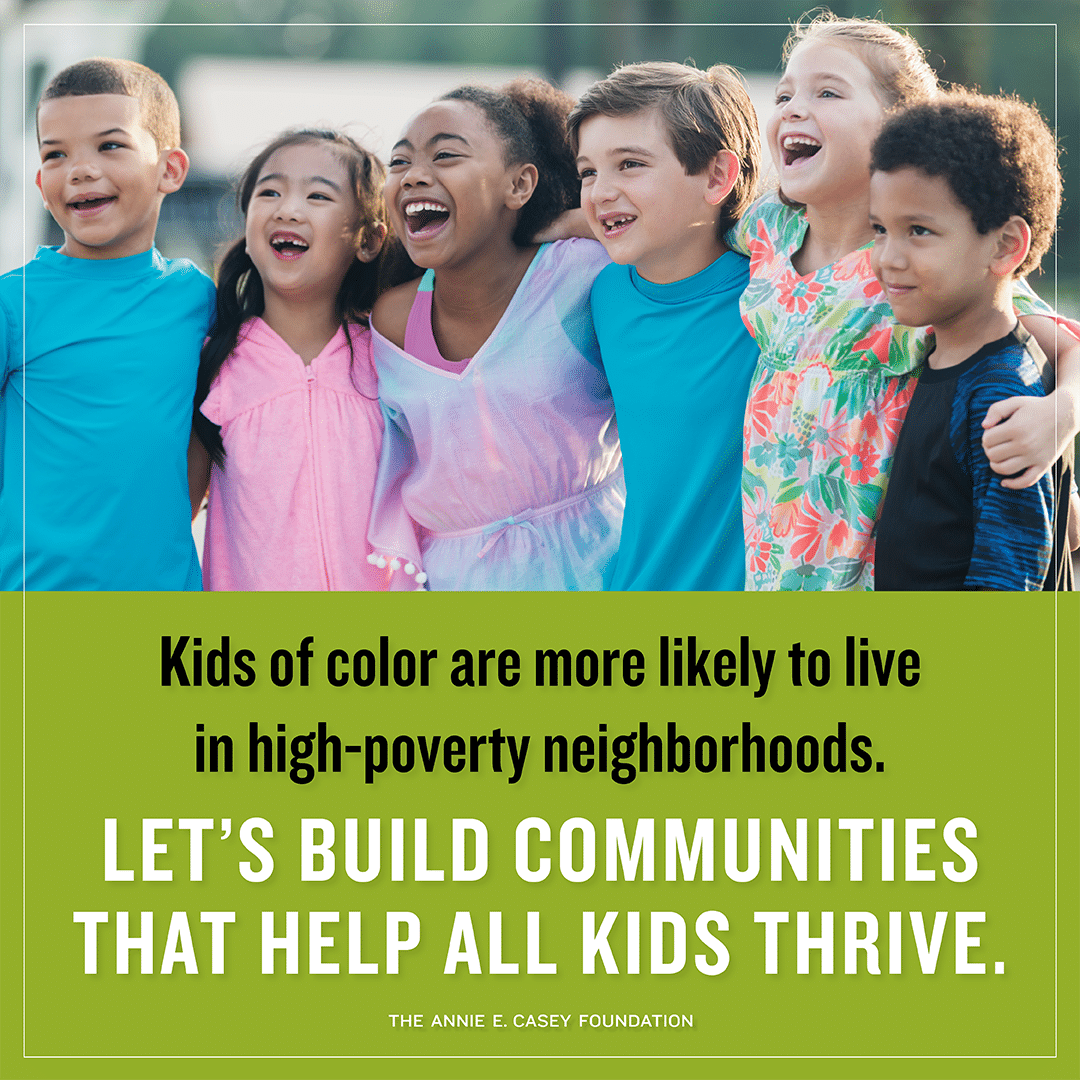Every child in Washington state deserves to live in a community where they are supported to grow, learn, and play. Kids and their families thrive when their neighborhoods have high-quality schools, good jobs, reliable transportation, and safe spaces for recreation. When our state invests in these essential building blocks, children are positioned to grow up healthy and well.
A KIDS COUNT data snapshot recently released by the Annie E. Casey Foundation shows that too many young people in Washington state live in neighborhoods facing high levels of poverty, whose institutions and infrastructure are under-resourced. The report, “Children Living in High Poverty, Low-Opportunity Neighborhoods,” finds that the U.S. overall has made mixed progress toward reducing concentrated poverty (communities where 30% or more of the population has income below the federal poverty level, or $21,330 per year for a family of three), despite a long period of economic expansion.
Disparities rooted in racism have worsened in recent years
The data show that 69,000 youth in Washington (4% of our child population) are growing up in neighborhoods that face concentrated poverty. While this marks a decline overall, the rates are higher for kids of color, who – because of persistent discrimination and a history of racist policies – are more likely than white kids to live in communities where many households struggle to make ends meet.
- In 2013 through 2017, disparities based on race worsened in our state for Black, American Indian and indigenous, and Asian and Pacific Islander youth since 2008-2012.
- During this period, the highest rates of Washington kids living in communities facing concentrated poverty were among Black children (10%), American Indian and indigenous children (10%), and Latinx children (9%).
- This means Black and American Indian and indigenous children were five times more likely to live in high-poverty neighborhoods than their white counterparts, and Latinx children were 4.5 times more likely.
This is the outcome of generations of racist policies, reinforced by present-day federal, state, and local decision-making that maintains racial inequity. Policymakers designed discriminatory housing, education, and economic policies that created neighborhoods with concentrated poverty, and they weakened the institutions serving those neighborhoods through disinvestment. Historically, this occurred through segregation; redlining; exclusionary zoning, and more. Inequality continues to be reinforced through housing discrimination and inadequate investment in affordable housing; unequal school funding; and Washington state’s upside-down tax code, which deprives communities of color of the resources they need to thrive.
It is critical to note that high-poverty neighborhoods also hold important assets – like cultural institutions, faith groups, and small businesses – which can foster a sense of community and belonging among children and families. Strategies to reduce concentrated poverty should not narrowly focus on moving children out of neighborhoods that face high poverty; instead, policymakers should leverage strategies that invest in under-resourced communities themselves.
Neighborhoods that face high rates of poverty pose risks to child well-being
Children in high-poverty neighborhoods tend to lack access to healthy food, strong schools, and quality medical care, and often face greater exposure to environmental hazards (like poor air quality and toxins such as lead). Economic hardship and lack of safe outdoor space can cause chronic stress linked to lasting health problems. And when kids who face these barriers transition to adulthood, they are more likely to have lower incomes than their counterparts who did not grow up in communities of concentrated poverty.
It is critical to note, however, that high-poverty neighborhoods also hold important assets – like cultural institutions, faith groups, small businesses, and connections to history and place – which can foster a sense of community and belonging among children and families. Strategies to reduce concentrated poverty should not narrowly focus on moving children out of neighborhoods that face a high poverty rate; instead, policymakers should leverage strategies that invest in under-resourced communities themselves, so that kids can thrive in the places they already live and are connected to.

State policymakers should invest in kids
Our state budget and tax code are powerful tools to advance the health and well-being of kids, their families, and our communities overall. As our state lawmakers prepare for the upcoming 2020 legislative session, they have the opportunity to reduce concentrated poverty and advance racial equity by:
- Taking steps to rebalance Washington state’s upside-down tax code by closing the tax break on capital gains (raising revenue for our communities by ensuring the wealthy pay their share) and enacting a modern Working Families Tax Credit (boosting income for Washingtonians working hard to get by).
- Funding the Communities of Concern Commission, which aims to leverage increased investments in communities of color across Washington state to build affordable housing, improve cultural centers, develop community infrastructure (like broadband access in rural communities), and more.
- Reinvesting in WorkFirst/Temporary Assistance for Needy Families. Supporting kids and parents to meet their basic needs stabilizes families and is linked to lasting benefits for child development.
Read the KIDS COUNT data snapshot, “Children Living in High Poverty, Low-Opportunity Neighborhoods,” for more.
